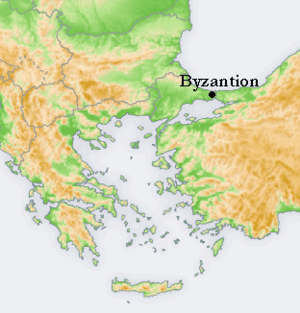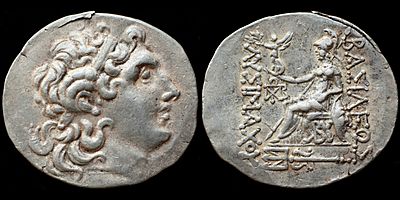Byzantium facts for kids
|
Byzantion
|
|

Location of Byzantion, corresponding to the modern-day Fatih district of Istanbul
|
|
| Alternative name | Byzantion (earlier Greek name), Nova Roma ("New Rome") |
|---|---|
| Location | Fatih, Istanbul, Turkey |
| Region | Marmara Region |
| Coordinates | 41°00′55″N 28°59′05″E / 41.01528°N 28.98472°E |
| Type | Ancient city |
| Part of | |
| Area | 6 km2 (2.3 sq mi) enclosed within Constantinian Walls 14 km2 (5.4 sq mi) enclosed within Theodosian Walls |
| History | |
| Founded | 667 BC |
| Cultures |
|
Byzantium (also called Byzantion) was an ancient Greek city. It later became known as Constantinople and is now called Istanbul. The name Byzantion was used for Constantinople sometimes. It was also used for the Byzantine Empire, which was the Eastern Roman Empire.
Greeks from Megara settled Byzantium in the 7th century BC. The city mostly spoke Greek until the Ottoman Empire took it over in 1453 AD.
What's in a Name?
The exact meaning of the name Byzantium is not fully known. Some think it comes from the Thracian language. It might be linked to the Thracian name Byzas, meaning "he-goat." An old Greek story says that Byzas was a king. He led the settlers from Megara and founded the city.
The people of Byzantion were called Byzántios or Byzántioi. In the Middle Ages, Byzántion also referred to the entire eastern Roman Empire. The word Byzantinós meant someone from the empire. From this, we get the English word "Byzantine."
Gold coins from the Byzantine Empire were called Byzantius or Byzantinus. This led to names like "besant" or "bezant" for these coins.
Later, the historian Hieronymus Wolf started using "Byzantium" in 1555. He used it to describe the whole Eastern Roman Empire. Before this, the people of the empire called themselves "Romans."
History of Byzantium
The beginning of Byzantium is part of ancient legends. A story says that Byzas from Megara founded the city. He sailed across the Aegean Sea to find it. This happened around 667 BC. This date comes from the historian Herodotus.
 |
|
| Front: Head of Alexander the Great with Amun's horns | Back: Seated Athena holding Nike with wreath, ΒΑΣΙΛΕΩΣ / ΛΥΣΙΜΑΧΟΥ; monogram (ΠΩΛΥΒ) to left; ΒΥ below throne; trident in exergue |
| Silver tetradrachm coin made in Byzantion around 150–100 BC. Byzantion made coins with Lysimachus's name almost 200 years after he died. | |
Byzantium was a very important trading city. This was because of its location. It was at the only entrance to the Black Sea. Later, Byzantium took over Chalcedon, another city across the Bosphorus strait.
The Persian Empire took control of Byzantium around 513 BC. This happened during Emperor Darius I's campaign. Byzantium was an important Persian port on the European coast.
During the Peloponnesian War, Greek forces attacked Byzantium. In 411 BC, Sparta took control of the city. They wanted to stop grain supplies to Athens. The Athenian military took the city back in 408 BC.
Byzantium was badly damaged in 196 AD. This happened after it sided with Pescennius Niger against Septimius Severus. But Emperor Septimius Severus rebuilt the city. It quickly became rich again.
The city's location was very strategic. It was easy to defend because water surrounded it. Roman Emperor Constantine I noticed this. In 330 AD, he rebuilt it as an imperial city. He called it Nova Roma. Later, it became known as Constantinople, meaning "city of Constantine."
Constantinople became a key link between Europe and Asia. It was a center for trade, culture, and diplomacy. For centuries, it was the capital of the Byzantine Empire. The city had many grand buildings. Its location helped it control major trade routes. These routes connected Asia and Europe. They also connected the Mediterranean Sea to the Black Sea.
On May 29, 1453, the Ottoman Turks conquered the city. It became the capital of the powerful Ottoman Empire. The Turks called the city "Istanbul." This name comes from a Greek phrase meaning "to the city." Today, Istanbul is still the largest city in Turkey.
City Emblem
Around the 1st century BC, the star and crescent symbol became linked with Byzantium. This symbol was also used by King Mithradates VI Eupator.
Some old Byzantine coins show the head of Artemis. She has a bow and quiver. On the other side, there is a crescent moon and an eight-rayed star.
In 340 BC, the Byzantines and their allies were under attack. Philip of Macedon was besieging their city. One dark night, Philip tried a surprise attack. But a bright light appeared in the sky. This light stopped his attack. Some say it was a meteor or the moon. Dogs also barked, warning the city.
To remember this event, the Byzantines built a statue. It was for Hecate, a goddess of light. Her symbols were the crescent and star. The Byzantines believed Hecate protected them. This is why her symbols became important to the city.
Cities in the Roman Empire often made their own coins. Many of these coins had symbols like stars or crescent moons. By the time of the Romans, coins with a star or crescent were common.
Famous People from Byzantium
- Homerus, a writer of tragedies in the early 3rd century BC
- Philo, an engineer who lived around 280–220 BC
- Epigenes of Byzantium, an astrologer from the 3rd–2nd century BC
- Aristophanes of Byzantium, a scholar in Alexandria from the 3rd–2nd century BC
- Myro, a female poet from the Hellenistic period
See also
 In Spanish: Bizancio para niños
In Spanish: Bizancio para niños

